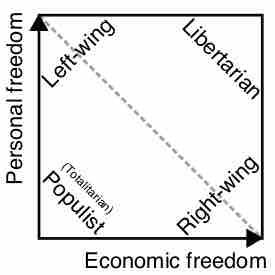Researchers have frequently noted that a single left-right axis is insufficient in describing the existing variation in political beliefs, and often include other axes. Though the descriptive words at polar opposites may vary, often in popular biaxial spectra the axes are split between cultural issues and economic issues, each scaling from some form of individualism (or government for the freedom of the individual) to a form of communitarianism (or government for the welfare of the community). In this context, the contemporary American on the left is often considered individualist (or libertarian ) on social/cultural issues and communitarian (or populist) on economic issues, while the contemporary American on the right is often considered communitarian (or populist) on social/cultural issues and individualist (or libertarian) on economic issues.
Numerous alternatives exist, usually developed by those who feel their views are not fairly represented on the traditional right-left spectrum. One alternative spectrum offered by the conservative American Federalist Journal accounts for only the "degree of government control " without consideration for any other social or political variable and, thus, places "fascism" (totalitarianism ) at one extreme and "anarchy" (no government at all) at the other extreme.
Other axes include: the focus of political concern (communitarianism vs. individualism), responses to conflict (conversation vs. force), the role of the church (clericalism vs. anticlericalism), foreign policy (interventionism vs. non-interventionism), and freedom (positive liberty vs. negative liberty). The Nolan Chart, created by libertarian David Nolan, shows what he considers as "economic freedom " (issues like taxation, free trade, and free enterprise) on the horizontal axis and what he considers as "personal freedom" (issues like drug legalization, abortion, and the draft) on the vertical axis. This puts left-wingers in the left quadrant, libertarians in the top, right-wingers in the right, and what Nolan originally named "populists" at the bottom.

The Nolan Chart
An alternative to the traditional political spectrum, the Nolan Chart positions opinions on economic freedom and personal freedom.